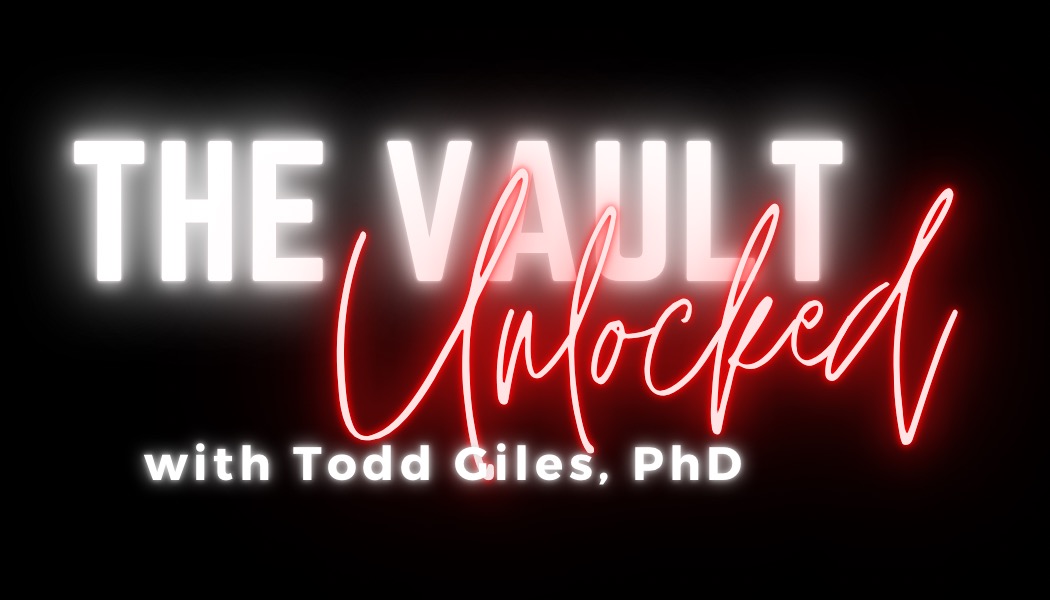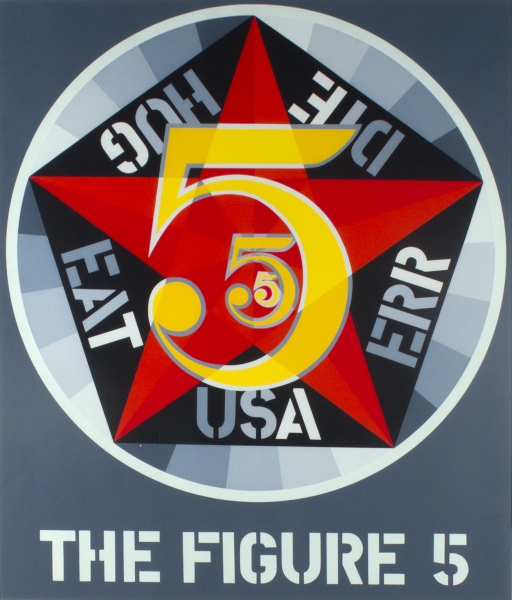
Ever wonder where the art is stored at the WFMA, and what's in there anyway? Join MSU professor Todd Giles as he unlocks the vault!

Robert Indiana
The Figure Five (From Decade Portfolio of ten prints), 1971
Screenprint
Signed, dated and numbered in pencil 58/200
Published by Multiples, Inc., New York & Los Angeles
Museum purchase assisted by the National Endowment for the Arts, 1975
“The Great Figure”
Among the rain
and lights
I saw the figure 5
in gold
on a Red
fire truck
moving
tense
unheeded
to gong clangs
siren howls
and wheels rumbling
through the dark city
~ William Carlos Williams
Robert Indiana’s The Figure Five is easily one of the most enigmatic artworks in the WFMA’s permanent collection. Even without an understanding of the multiple allusions in the work, one can still enjoy its many geometric shapes, bold lines, bright colors, oddly paired three-letter words, and that strange triad of floating number fives, which seem to add a certain perspective and depth to an otherwise flat image. Add to these things Indiana’s self-lineage-making, and The Figure Five takes on a multitude of art-historical, autobiographical, and extra-literary meanings. We’ll explore those things here. To do so, we begin with a quote from 19th century American poet Walt Whitman as he begins his own identity-making journey in “Song of Myself”:
My tongue, every atom of my blood, form'd from this soil, this air,
Born here of parents born here from parents the same, and their parents
the same . . .
Here we see the poet, within a few lines of the opening of his poem, working to establish his Americanness; that is, his self-described legitimacy to speak of and for the nation, for “Song of Myself” is less about Whitman himself than it is about the poet working to encapsulate the entirety of the nation, while at the same time developing an entirely new language and literary form within which to do so. Whitman is telling us from the get-go that he, as an emblematic American made up of the selfsame soil the new nation is being built from, is in the ideal position to do so.
Robert Indiana does something similar just over one hundred years later in 1961, only rather than pointing back to his familial bloodline (he was adopted at an early age), he speaks back to some of our most important 19th and early 20th century writers and artists to forge his own lineage, quoting directly from, for example, Herman Melville, Hart Crane, Charles Demuth, Marsden Hartley, and yes, Walt Whitman, among others. It is interesting to note that while so many of the artists working after World War II were moving forward by breaking free from Europe’s artistic past, Indiana was looking back to the genesis of America’s artistic culture to find his own unique voice and identity.
Sculptor, painter, printmaker, poet, and stage set designer, Robert Indiana (1928–2018) was born Robert Clark in New Castle, Indiana. For better or worse, Indiana is primarily known for his iconic LOVE sculpture that became ubiquitous in the late 60s and early 70s. It was seen on everything from postage stamps, paper weights, and cufflinks, to being mimicked in countless advertising campaigns. You might even have had the privilege of seeing a version of the sculpture yourself on the campus of the University of Oklahoma in Norman, where it still stands today. Like many post-WWII artists, Indiana worked serially, creating several different versions of a work, often across different media, which, like LOVE, is the case for the screenprint under consideration here as well.
Since his explosion onto the New York art scene in the early 1960s, Indiana has tended to be lumped together with Pop artists such as Roy Lichtenstein, Andy Warhol, James Rosenquist, Jim Dine, and Tom Wesselmann, all of whom are likewise represented in the WFMA’s permanent collection. While Indiana adopts a visual rhetoric similar to his Pop colleagues—bright colors, advertising-sharp hard-edged lines, and flatness of field—his work is more inward-facing than outward-facing; that is, it is less a critique of our surface-level production/consumption driven world than it is an interior exploration of the artist’s autobiographical establishment of and musings on his place among his literary and artistic forebearers. In that sense, even though his work looks nothing like that of his Abstract Expressionist precursor Robert Motherwell, one could argue that their mutual engagement with literature sets them apart from their colleagues through their interest in language and writing. One could likewise situate Indiana’s symbolic portraits alongside Modernist author Gertrude Stein’s poetic portraits of artists such as Pablo Picasso, which are “painted” through sounds and personal word associations to build narrative rather than direct references to character or physical traits.
Indiana’s screenprint The Figure Five was part of the Decade Portfolio, a series of works on paper produced in 1971 by Multiples, Inc., comprised of two hundred sets of ten of the artist’s most important paintings to date. (For a discussion on originality and prints of earlier paintings, see my essays on Jasper Johns and Lee Krasner). Things can get confusing when discussing multiples in a series; suffice it here to say that Indiana composed five different oil paintings on his Charles Demuth theme in 1963: The Figure Five, The Demuth Five, The Small Demuth Diamond Five, The Demuth American Dream No. 5, and X-5.
Before diving into The Figure Five, some background on Demuth is in order. Charles Demuth (1888–1935) was an American Modernist artist whose 1928 painting The Figure 5 in Gold captivated Indiana. According to the artist, it was his “favorite American painting in New York City’s Metropolitan Museum.” Demuth’s painting brings together several elements of modern art at a time when American painters were beginning to find their own voices after having been shocked into modernity by seeing the latest European avant-garde art at the Armory Show in New York in 1913. In The Figure 5 in Gold, we see the fragmentation of Cubism, the dynamism of Futurism, and the clean lines of Precisionism wedded together to create a vibrant “poster portrait” of Demuth’s friend, American poet William Carlos Williams. We also, in retrospect, can see elements of what would become Pop Art a few decades later.
Along with The Figure 5 in Gold, Demuth composed a series of abstract portraits of some of his other artist and writer friends, including Arthur Dove, John Marin, and Georgia O’Keeffe. The Williams portrait is based on the 1920 poem titled “The Great Figure” which precedes this essay. “The Great Figure” is itself a sort of Cubist take on a fleeting experience Williams had one evening while walking to his artist friend Marsden Hartley’s studio in New York City. (Indiana was also very interested in the work of Hartley, composing several paintings based on his work as well).
In The Figure Five, Indiana kept the same color pallet used in Demuth’s earlier portrait, but he surgically extracted the three fives, leaving behind his predecessor’s Cubist cityscape of buildings, marquees, streetlights, and the retreating red fire engine, as well as the linguistic nods to Williams (“Bill,” “Carlo,” “W.C.W”). For his double-homage to poet and painter, Indiana maintained the fragmented grey strips that represent Demuth’s street on which the fire engine travels, only in The Figure Five, they are presented in his by-now trademark roulette-like circle, which is here composed of five repeated sets of five shades grey. Overlaid atop the circle, Indiana includes a solid black pentagon, a two-toned five-pointed red star, Demuth’s three gold fives as originally depicted, and five cryptic three-letter words. All of this is encased by a light grey circle, below which resides the artwork’s title in large light grey letters.
There is a lot to unpack here, and who better to get us started than the artist himself; here he is speaking of his earlier The Demuth American Dream No. 5:
For in 1928, the year of my birth, Demuth painted his ‘picture’ inspired by his friend’s poem ‘The Great Figure.’ . . . I did my painting in 1963, which when subtracted by 1928, leaves 35—a number suggested by the succession of three fives (5 5 5) describing the sudden progression of the firetruck in the poet’s existence. In 1935 Demuth died . . . and then in 1963 the venerable doctor died, completing he unpremeditated circle of numerical coincidence . . .” (qtd. in Haskell 225).
Numbers. Dates. Shapes. Symbols. Colors. Layer upon layer of meaning make up this work—literal, metaphorical, and personal. Stepping back from the work a bit to garner the perspective of a birds-eye view, the whole thing calls to mind mid-century roadside signage, particularly gas station signs like Texaco, Chevron, Shell, and so on. (Side note: Indiana’s dad worked at a gas station at one point when his son was growing up).
As mentioned earlier, one of the intriguing things about Indiana’s work is the way he very intentionally set out to create a lineage for himself, one deeply woven into the American artistic past. Incorporating quotes from some of our nation’s major literary figures is one thing, but the thought Indiana put into creating a relationship with Demuth and Williams operates on a whole different level.
Perhaps the most confounding element of this meticulously hard-edged, multi-layered work are the five words circling the star: “USA,” “EAT,” “HUG,” “ERR,” and “DIE.” They are at one and the same time ambiguous and evocative. Are they meant to shed light on the sign? Add meaning to it? Work in conjunction with the shapes and colors? Speak back to Demuth’s and Williams’s original works? Just like roadside signs themselves, words stand in for and point to something other than themselves—the old sign and signifier routine. All these words play a major role throughout Indiana’s oeuvre; all five, for example, appear in the fifth painting in his American Dream series. Like Jim Dine’s repeated bathrobes and Andy Warhol’s multiple Marilyns, these words, like Indiana’s iconic “LOVE,” have become synonymous with his brand, if you will. According to art historian Barbara Haskell, “Indiana identified these elements as ‘existence and love and survival and sin,’ which he conveyed by the words ‘DIE,’ ‘HUG,’ ‘EAT,’ and ‘ERR’” (66). In other words, the cycle of life is encircled around the five-pointed star, which for Indiana represents America. We live and we die; we make mistakes; we ask for forgiveness; we eat to survive; and we show love and compassion.
My initial thoughts when first encountering The Figure Five in an exhibition at the WFMA more than a decade ago were that Indiana was wryly commenting on the shallowness of the American Dream, as was the general program of the Pop artists. With further research and consideration, though, I see this work more complexly, more akin, say, to T.S. Eliot’s narrator at the end of The Waste Land, who shores up the remaining post-WWI fragments of culture as best he can to build something new.
In The Figure Five, we see a young artist—like Whitman “[b]orn of parents born here from parents the same” — forging his place in American arts and letters not by bringing together the surface-level Elvises and Campbells soup cans so emblematic of our insatiable hunger for cheap food and entertainment, but rather one tapping a deeper root into a more nutrient-rich soil nourished by some of our most forward-looking artists and writers. William Carlos Williams, who likewise worked to create a unique American idiom, would call it working “In the American Grain.”
Works Consulted
Haskell, Barbara. Robert Indiana: Beyond Love. Yale UP, 2013.
Ryan, Susan Elizabeth. Robert Indiana: Figures of Speech. Yale UP, 2000.
The Figure Five from the Permanent Collection of the Wichita Falls Museum of Art at MSU Texas
View Previous The Vault Unlocked
-
Tuesday - Friday
10:00AM - 5:00PMSaturday
1:00PM - 5:00PM